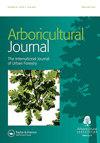Factors affecting the design coordination of trees and underground utilities in new developments in the UK
Q3 Agricultural and Biological Sciences
引用次数: 3
Abstract
ABSTRACT The successful coordination of tree and utility layouts, particularly at the design stage of a development, would minimise conflicts and maximise benefits for both trees and utilities. This study assessed the extent to which trees and underground utilities in new developments in the UK are coordinated by design and the factors that help or hinder this coordination. Landscape architects and design teams at housing developers and utility companies in north-west England were surveyed online regarding their experiences of tree/utility design coordination and asked to suggest how coordination could be improved. Results indicated that overall responsibility for utility layout design was unclear and the timing of first coordination between trees and utilities varied widely. First coordination was often at the technical design stage or later; 92% of respondents had at some stage experienced first coordination to be during site construction. Where designed locations for trees and utilities coincide, utilities currently take precedence, commonly due to cost implications (52% of respondents). Trees may, more rarely, take precedence if, for example, they are seen as a special priority. Coordination during design was considered constrained by lack of knowledge (46% of respondents) and by fixed priorities (41% of respondents), but also by cost concerns, poor communications, technical restrictions and lack of incentives. Respondents considered that coordination could be improved by earlier and ongoing communications, improved knowledge, effective enforcement and an openness to discussion and to new methods of utility installation and tree establishment.影响英国新开发项目中树木和地下设施设计协调的因素
成功地协调树木和公用设施的布局,特别是在开发的设计阶段,将最大限度地减少冲突,并使树木和公用设施的利益最大化。本研究评估了英国新开发项目中树木和地下设施在设计上的协调程度,以及有助于或阻碍这种协调的因素。英格兰西北部的房地产开发商和公用事业公司的景观设计师和设计团队进行了在线调查,了解他们在树木/公用事业设计协调方面的经验,并要求他们提出如何改进协调的建议。结果表明,公用事业布局设计的总体责任不明确,树木和公用事业之间首次协调的时间差异很大。第一次协调通常是在技术设计阶段或之后;92%的受访者在某个阶段经历过现场建设期间的第一次协调。在树木和公用事业的设计位置重合的地方,公用事业目前优先考虑,通常是由于成本问题(52%的受访者)。例如,如果树被视为具有特殊优先级,则在更罕见的情况下,它们可能会优先考虑。设计过程中的协调被认为受到缺乏知识(46%的受访者)和固定优先级(41%的受访者)的限制,但也受到成本问题、沟通不良、技术限制和缺乏激励的限制。答复者认为,可以通过早期和持续的沟通、改进知识、有效的执法以及对讨论和安装公用设施和建立树木的新方法持开放态度来改善协调。
本文章由计算机程序翻译,如有差异,请以英文原文为准。
求助全文
约1分钟内获得全文
求助全文
来源期刊

Arboricultural Journal
Agricultural and Biological Sciences-Agronomy and Crop Science
CiteScore
2.40
自引率
0.00%
发文量
28
期刊介绍:
The Arboricultural Journal is published and issued free to members* of the Arboricultural Association. It contains valuable technical, research and scientific information about all aspects of arboriculture.
 求助内容:
求助内容: 应助结果提醒方式:
应助结果提醒方式:


